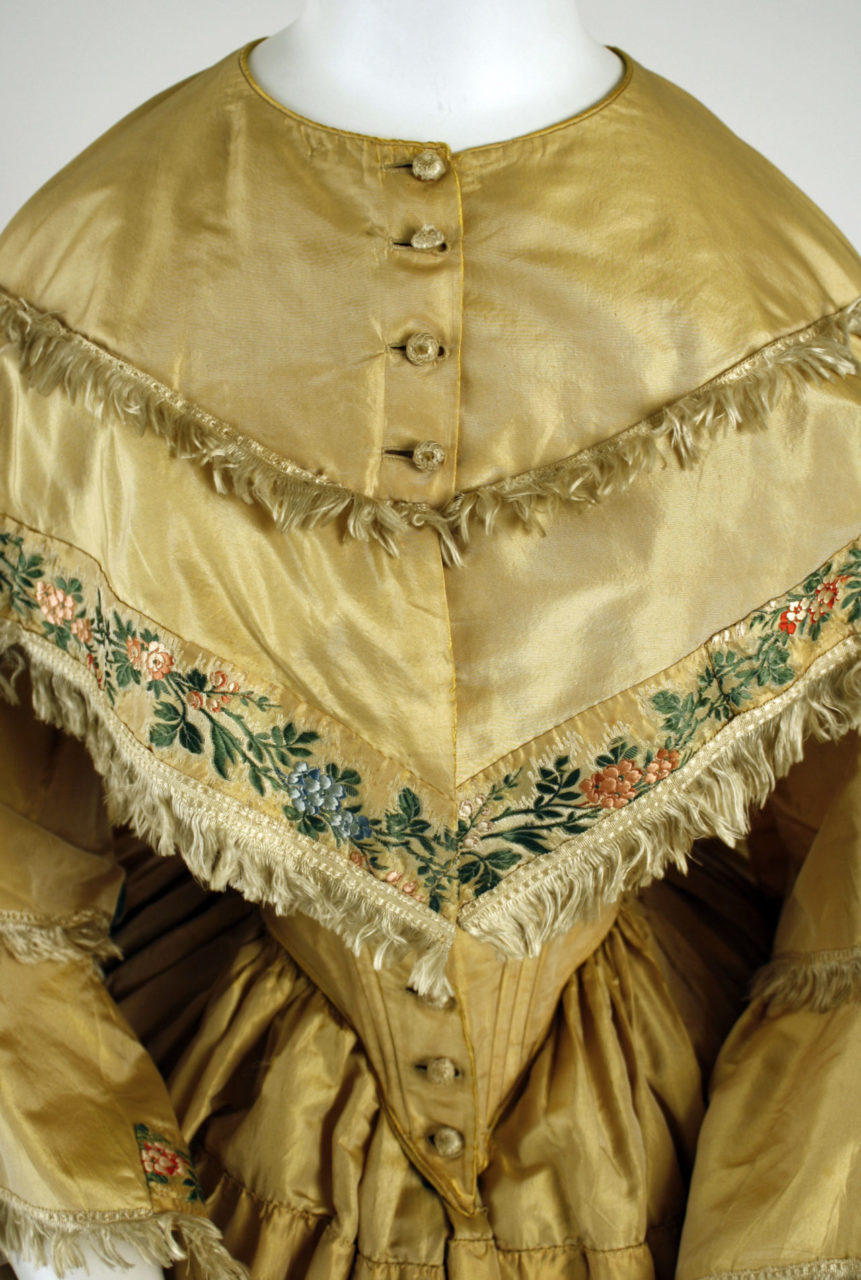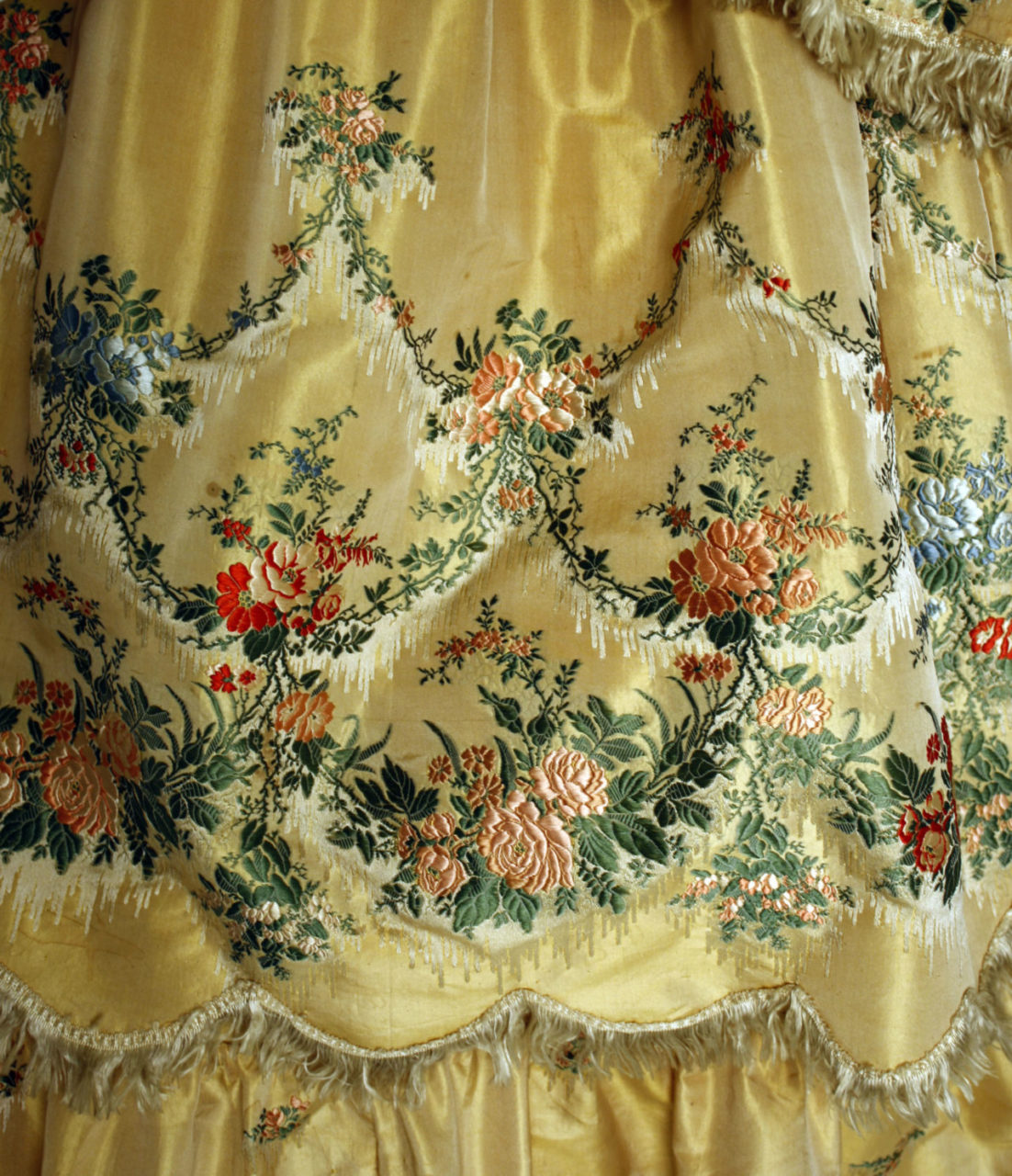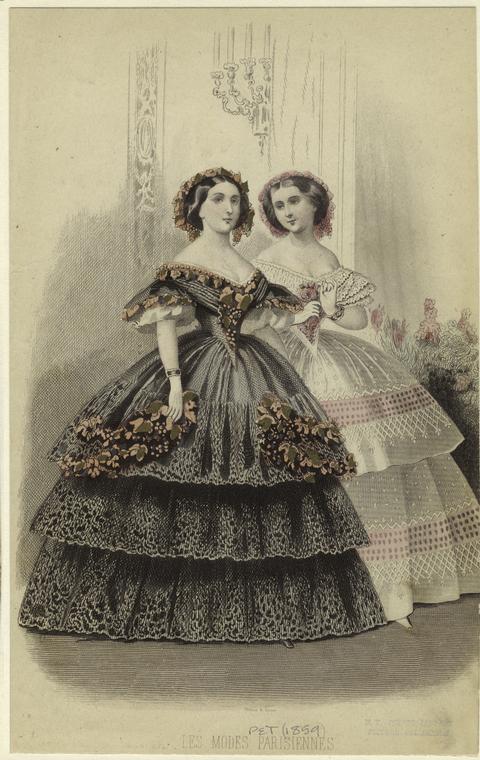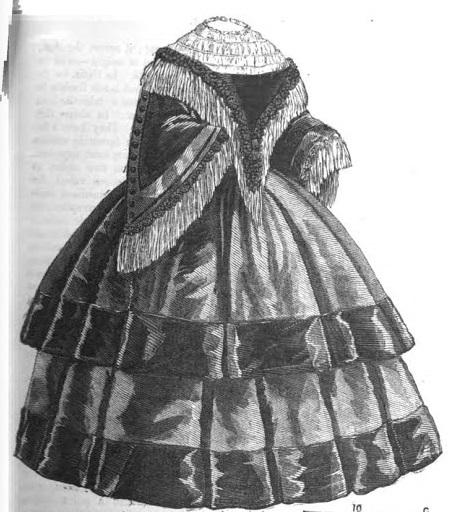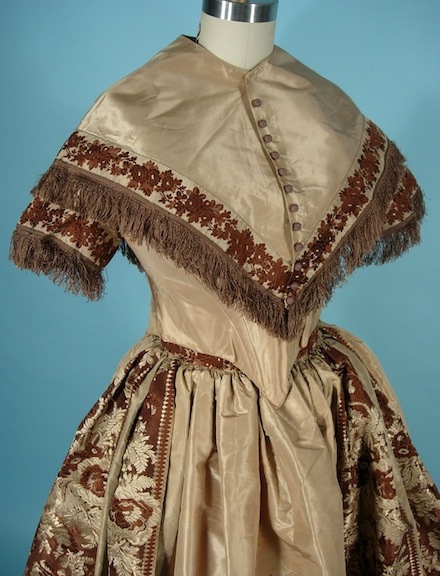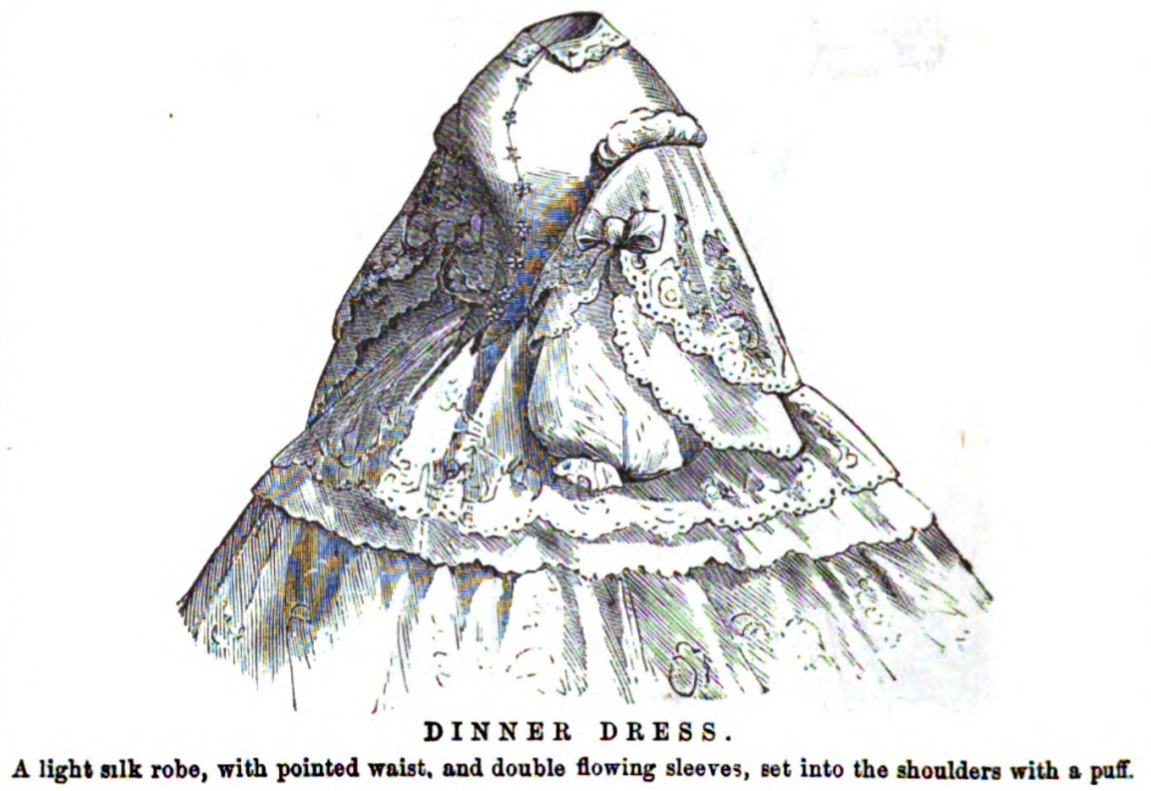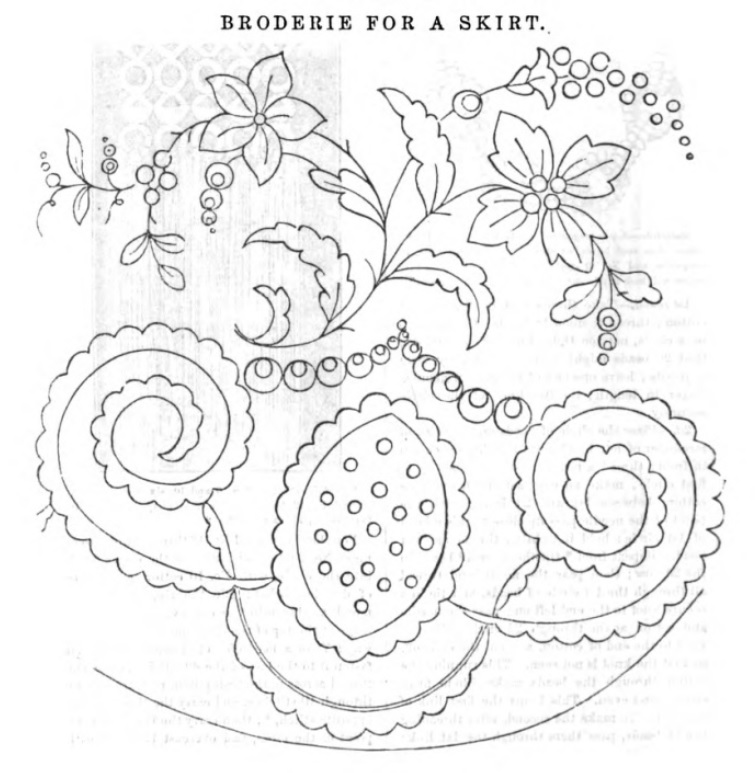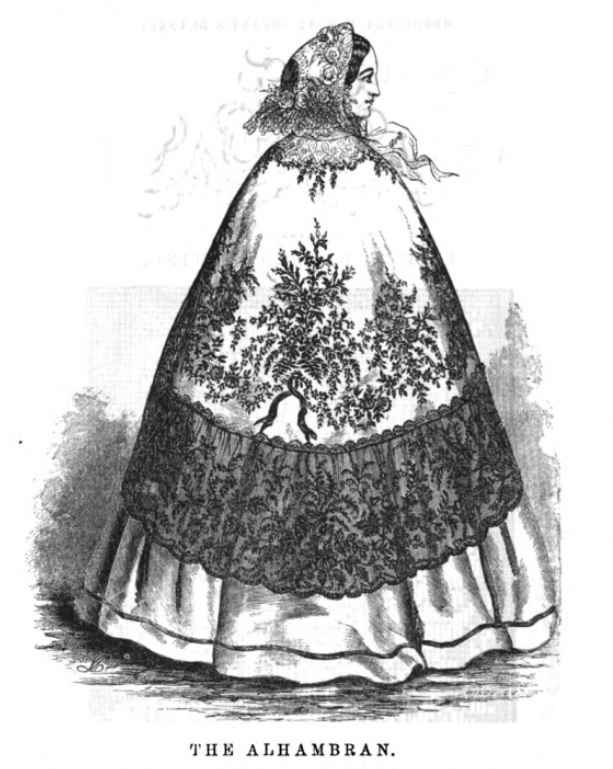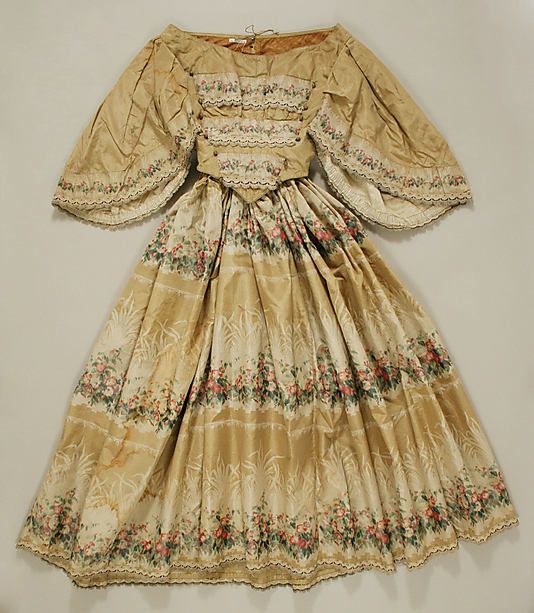While the silhouette of this day dress, its floral brocade, and its use of fringe were fashionable for 1859, its choice of gold silk fabric and naturalistic coloring for the flowers was less so.
About the Look
This 1859 ensemble has a gold, two-tiered skirt and pagoda-sleeves, both of which are edged in a red, green, and peach floral brocade pattern. This silk day dress has a round-necked bodice with a frayed v-shaped seam above the bust and frayed edges (Fig. 1). The edges of the tiers of the pagoda sleeves are also frayed, as are the two tiers of the large, round cage crinoline-shaped skirt. The bust-level tier of the bodice, alongside both tiers of the pagoda sleeves, have an approximately two-inch-wide green and red floral brocade pattern, while both tiers of the skirt are adorned with a pattern similar to that of the bodice and sleeves. But the patterning also creates the illusion of additional tiers on the skirt by depicting what appear to be frayed, scalloped edges (Fig. 2). The edges of the bust-level tier of the bodice and both edges of the pagoda sleeves are straight, while the edges of the tiers of the skirt are scalloped. Gold buttons start at the center top of the bodice and extend beneath the bodice tier down the center front of the pointed bodice.
Fig. 1 - Designer unknown (American). Dress, 1859. Silk. New York: The Metropolitan Museum of Art, C.I.52.55a, b. Gift of Mr. Ephraim Segal, in memory of Brucha Jersawitz, 1952. Source: The Metropolitan Museum of Art
Fig. 2 - Designer unknown (American). Dress, 1859. Silk. New York: The Metropolitan Museum of Art, C.I.52.55a, b. Gift of Mr. Ephraim Segal, in memory of Brucha Jersawitz, 1952. Source: The Metropolitan Museum of Art
Dress, 1859. Silk. New York: Metropolitan Museum of Art, C.I.52.55a, b. Gift of Mr. Ephraim Segal, in memory of Brucha Jersawitz, 1952. Source: The MET
About the context
T here is sufficient evidence to suggest that this 1859 garment was fashionable in its year. In general, the silhouette of the pagoda sleeves, high round collar, and two-tier skirt, was one that was often reproduced in fashion plates (Fig. 3). Many fashion plates from 1859 portray the two-tier skirt, intricate shoulder, and pointed bodice look as a popular look for both day and evening dresses (Fig. 4).
Fig. 3 - Artist unknown (1859). Women 1857-1859, Plate 240, 1859. New York: The Metropolitan Museum of Art, b17509853. Gift of Woodman Thompson. Source: The Metropolitan Museum of Art
Fig. 4 - Artist unknown. Les Modes Parisiennes, 1859. New York: The New York Public Library Digital Collections, b17122153. Source: The New York Public Library Digital Collections
For example, the combination of round collar, pagoda sleeve, and two-tier skirt became enough of a staple fashion choice that in a fashion plate of five figures, three women and a young girl would be dressed in that manner (Fig. 5). Aside from the general silhouette and larger design aspects of the dress, smaller portions of the design, like fringe and scalloping, were also common.
Fig. 5 - Artist unknown (American, 1859). Godey's Ladies' Book, April, 1859. Source: Vintage Victorian
Fig. 6 - Artist unknown. Dress, 1859. Source: The What-Not; or Ladies' Handy-book
Regarding these details, The What-Not; or Ladies’ Handy-Book of 1859 portrays a dress very similar in style, including fringe on the sleeves and the bust-tier (Fig. 6):
“The dress we have given in our illustration is of violet coloured silk, having a double skirt, both the upper and under one being bordered with a velvet of darker shade. The body is made low, with a point before and behind; it is the trimming that gives the peculiarity to this dress… The edge of this double stomacher is trimmed in an effective manner. It is first set round with Maltese lace, either of black or its own colour, to the edge of which a rich, deep fringe is added, set round every scallop.” (22)
Evidently, fringe was a fashionable method of detailing a dress in 1859. As seen in an 1860 evening dress, the trend continued throughout and lasted until at least 1860 (Fig. 7).
Fig. 7 - Designer unknown. Evening dress, 1860. Taffeta and brocade. Source: Antique Dress
Fig. 8 - Artist unknown. Dinner dress, 1859. Source: Hathi Trust Public Library
Fig. 9 - Artist unknown. Broderie for a Skirt, 1859. Source: Hathi Trust Public Library
Alongside the fringe, another key detail of the dress is the floral brocade pattern that is highlighted on the gold fabric. The shaped brocade decoration creates a valuable illusion, which is to make it seem as if there are more than two tiers to the scalloped skirt. The trendiness of the scalloped skirt and pagoda sleeves can be observed in a Lady’s Home Magazine dress illustration (Fig. 8). A scallop-edged floral embroidery design taught in an 1859 issue of Godey’s Ladies’ Book (Fig. 9) also resembles the decorative pattering on the dress. A later image (Fig. 10) showcases a very similar floral lace design, and the writer of Godey’s Ladies’ Book emphasizes the importance of patterned brocades:
“This truly elegant garment for the spring wear is of heavy taffeta, wrought in the loom, with exquisite designs in black velvet, upon a variety of different coloured grounds. The shape is the ‘Royal Spanish’, with a deep fall of black lace, beaded with a narrow purling of the same material. The tout ensemble is elegance itself.” (264)
Fig. 10 - Artist unknown. The Alhambran, 1859. Source: The Hathi Trust Public Library
Fig. 11 - Designer unknown. Dress, 1857. Source: Pinterest
The magazine illuminates how the heavy detailing should be applied to a lighter base color, as is the case in the gold dress. An important aspect to question is if the fabric choice of the gold dress was a fashionable choice. Both Godey’s Ladies’ Book and The What – Not; or Lady’s Handy – book, elaborate on how black velvet is the go-to fabric choice for these types of silhouettes and detailing combinations, while the gold dress is purely silk. Yet a similar gold silk dress with a horizontal printed pattern that also creates the illusion of tiers also survives (Fig. 11), suggesting it was not uncommon. Despite differences in fabric choice, the gold silk dress and its many design aspects seem to be very fashionable for the year that it was made.
References:
-
Godey’s Lady’s Book and Magazine. Vol. 58, 1859. https://books.google.com/books?id=N8JZAAAAYAAJ&pg=PA264.
- “The Fashions.” The What-Not; or Ladies’ Handy-Book, 1859, 20–22. https://books.google.com/books?id=dlYEAAAAQAAJ&pg=PA22.


